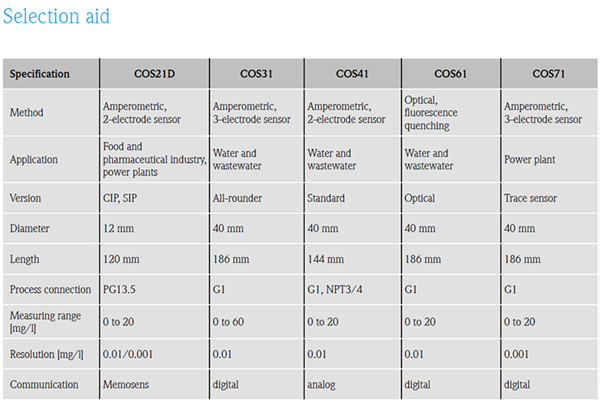Dissolved Oxygen Measurement Sensors
Competence in dissolved oxygen measurement A solution for every industry – this is dissolved oxygen measurement from Endress+Hauser. The range spans from
controlling the aeration of activated sludge basins in wastewater treatment and residual oxygen measurement in power station boiler feedwater, to controlling fermentation
in food processing and optimizing color and taste in the production of red wine. Two types of technology are deployed in sensory measuring technology: the well-known
and tried-and-tested amperometry - here oxygen concentrations are converted to electric currents - and the optical method of fluorescence quenching which is relatively
new in process measuring technology.
Here, the fluorescing light of an oxygensensitive molecule is used to determine the concentration. In the transmitter, the signals are processed further for the desired display.
How does the medium get to the sensor?
In immersion operation, such as in open basins or channels, the sensor is suspended in the medium from an immersion assembly and the medium flows around it. In closed
pipe systems, a flow assembly is often used in bypass operation while tanks are accessed via stationary-mounted retractable assemblies. The latter allow the sensor to be
removed even if the tank is full. every production area, Endress+Hauser has achieved a great vertical range of production. As a result, the client receives high and constant product
quality as well as excellent delivery reliability for all standard products and for individual products tailored to suit special applications. Measuring technology
from Endress+Hauser stands for reliable measured values, a high degree of availability and long operating times.
Competence in dissolved oxygen measurement
A solution for every industry – this is dissolved oxygen measurement from Endress+Hauser. The range spans from controlling the aeration of activated sludge
basins in wastewater treatment and residual oxygen measurement in power station boiler feedwater, to controlling fermentation in food processing and optimizing color and
taste in the production of red wine. Two types of technology are deployed in sensory measuring technology: the well-known and tried-and-tested amperometry - here
oxygen concentrations are converted to electric currents - and the optical method of fluorescence quenching which is relatively new in process measuring technology.
Here, the fluorescing light of an oxygensensitive molecule is used to determine the concentration. In the transmitter, the signals are processed further for the desired display.
How does the medium get to the sensor? In immersion operation, such as in open basins or channels, the sensor is suspended in the medium from an immersion assembly
and the medium flows around it. In closed pipe systems, a flow assembly is often used in bypass operation while tanks are accessed via stationary-mounted retractable
assemblies. The latter allow the sensor to be removed even if the tank is full.
One of the most well known applications of oxygen measuring technology in liquids can be found in the activated sludge basin in wastewater treatment. Here oxygenation in the basin must be regulated - too little oxygen means too little degradation, too much oxygen means high energy costs.
Channels and open basins are the domain of the oxygen sensor mounted in the immersion assembly. The immersion assembly means that the sensor can be installed in such a way that only the sensing part is in contact with the medium. Modules such as the cable gland are protected and dry within the assembly pipe. The assembly itself can be immersed into the medium using a chain and boom or mounted directly on the edge of the basin in the event of high fluid velocities. The transmitter is mounted under the weather protection cover at the upright post, which also forms the boom for the assembly chain – all in one place.
Liquisys M COM223/253
Oxymax W
COS31/61
DipfitCYA611
CYH101 assembly holder
Oxymax W
COS41
5
Oxygen in the activated sludge basin
Liquisys M COM223/253 transmitter
• Modes of operation: mg/l, ppm, hPa, % SAT
• Two-line display
• Optionally with 2/4 contacts(limit contacts, P(ID) controller, timer)
• Optionally with Profibus-PA/-DP or HART®
CYA611 Dipfit immersion tube
• Immersion assemblyin PVC version
• For open basinsand channels
• Length 1630 mm
Oxymax W COS31 oxygen sensor
• Measuring range 0 to 60 mg/l
• Digital sensor
Oxymax W COS41
• Measuring range 0 to 20 mg/l
Oxymax W COS61
• Measuring range 0 to 20 mg/l
• Digital optical sensor
CYH101 universal suspended assembly holder
• Stainless steel column for securing transmitter and immersion tube
• Fixed and oscillating method of securing immersion tube
Liquisys M COM223/253 transmitter
• Modes of operation: mg/l, ppm, ppb, hPa, % SAT
• Two-line display
• Optionally with 2/4 contacts(limit contacts, P(ID) controller, timer)
• Optionally with Profibus-PA/-DP or HART®
• Oxymax W COS71
Flowfit W COA260 flow assembly
• Minimum sample volume
• Fluid velocity200 to 600 ml/min
• Oxymax W COS71
Oxymax W/H COS71/COS21D-Coxygen sensor
• Trace sensor
• Resolution 1 ppb
• COS71: Ø 40 mm COS21D-C : Ø 12 mm
Liquiline M CM42
• Two-wire transmitter for easy installation with large display and alarm LED
• Simple, intuitive operation due to Navigator, plain text menu and online help
• Second current output
• Oxymax H COS21D-C

- Pre:Endress Hauser FMI51 with Leve 2013/6/11
- Next:Improve the bunker procedure o 2013/6/11
